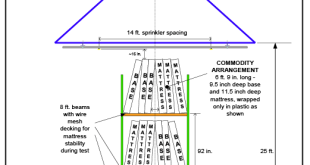CORRECTING DEFICIENCIES AND REPAIRS FOR FACILITY MANAGERS
The inspection, testing, and maintenance (ITM) of water-based fire protection systems is similar to a vehicle’s inspection, testing, and maintenance. Vehicle owners are required to maintain fuel levels, check directional and brake light functions, and monitor tire tread. As a building owner or designated representative, you must ensure that the control valve of a sprinkler system is open, the pressure is maintained, and the alarm valve is in decent shape.
As time passes and the vehicle is used, various components need more attention and a professional to dive deeper into any problems. Vehicle manufacturers recommend inspections at specific mileage intervals, and some states require an annual inspection. Following automotive servicing, a list of potential issues, critical concerns, and preventative maintenance items is presented to the owner. The owner must then prioritize those items based on risk, budget, or the owner’s ability to make the repairs him/herself. There is not much of a difference between this process and that of a sprinkler system, except that the sprinkler system is used less often. So, to relate to the topic, don’t park your vehicle outside for six months to a year and expect that it will work safely the next time you drive it!
NFPA 25 REQUIREMENTS
For building owners or designated representatives, ITM requirements (or the owner’s manual) are clearly outlined in section 4.1 of NFPA 25, Standard for the Inspection, Testing, and Maintenance of Water-Based Fire Protection Systems, 2023 edition. While the facility manager may not own the building, they are often the designated representative of the building owner to act as their agent and comply with the requirements of section 4.1. This includes ensuring the building systems function as intended, managing repair and maintenance tasks within a budget, and hiring knowledgeable and trained contractors to maintain the building system when the required tasks are outside of their team’s expertise, capabilities, or jurisdictional requirements. The ITM tasks required by NFPA 25 are reported by the hired contractor for information within the scope of the contract. These items are classified as a noncritical deficiency, a critical deficiency, an impairment, or no deficiency found.
3.3.8* Deficiency. For the purposes of inspection, testing, and maintenance of water-based fire protection systems, a condition that will or has the potential to adversely impact the performance of a system or portion thereof but does not rise to the level of an impairment.
3.3.8.1 Critical Deficiency. A deficiency that, if not corrected, can have a material effect on the ability of the fire protection system or unit to function as intended in a fire event.
3.3.8.2 Noncritical Deficiency. A deficiency that does not have a material effect on the ability of the fire protection system or unit to function in a fire event, but correction is needed to meet the requirements of this standard or for the proper inspection, testing, and maintenance of the system or unit.
3.3.23* Impairment. A condition where a fire protection system or unit or portion thereof is out of order, and the condition can result in the fire protection system or unit not functioning in a fire event.
Per NFPA 25, the property owner or designated representative must correct or repair deficiencies or impairments. This means that someone must prioritize the findings and authorize or hire knowledgeable and trained personnel to complete the tasks. The prioritization will include risk, cost, and enforcement.
4.1.5.1* The property owner or designated representative shall correct or repair deficiencies or impairments.
The risk and cost are based on the perspective of the situation. The following information is an example of potential findings, classifications, and prioritization for discussion purposes. Other examples are provided in the annex (A.3.3.8) of NFPA 25.
EVALUATING DEFICIENCIES
Suppose an inspection has been performed and the following deficiencies have been identified:
• Missing hydraulic information sign
• Storage within 18 inches of a standard spray sprinkler deflector
• Control valve not operating through its complete range of motion
Let’s review each deficiency in the context of NFPA 25 requirements.
Missing hydraulic information sign – A sprinkler system missing a hydraulic information sign is considered a noncritical deficiency, as the sprinkler system does not need the sign to function. Overall, a missing hydraulic information sign has a low potential for risk, assuming that change management has been in place throughout the building’s lifetime. In this case, it is also an easy fix. In a facility that has up-to-date drawings and the system acceptance documentation, the cost to produce and post hydraulic information is minimal. However, missing hydraulic data may be considered an item of importance and a higher potential risk for a facility that has been newly acquired without the initial construction documents or as-builts, as it could mean that the existing system may not sufficiently protect life or property given the current hazards and conditions within the space. In this case, it becomes much more expensive because the system must be reverse-engineered to determine its protection capabilities.
Storage within 18 inches of a standard spray sprinkler deflector – This may be classified as a critical deficiency as it can prevent the sprinkler from developing a spray pattern for sufficiently controlling a fire below. Standard spray sprinklers with storage within 18 inches of the sprinkler deflector pose a moderate to high risk but, most of the time, can be rectified with the minimal effort that it takes to move the storage and train people in the area to maintain the storage greater than 18 inches below the sprinkler deflector.
Control valve not operating through its complete range of motion – This is an example of the most serious type of deficiency. It is classified as an impairment as it can occlude the water supply, drastically affecting the flow of sprinklers in a fire condition. It poses a moderate to high risk if not fixed and may be costly as it may require draining the upstream and downstream system or completing a flush following an obstruction investigation. The risk may be considered moderate when the system feeds a small unoccupied outbuilding that is 200 feet from the facility but high if the system is feeding a nursing home with occupants of altered or limited mobility.
The first thought you may have when reading this is that all deficiencies must be fixed, and you’re right, but there are many considerations when a facility manager determines priorities. To relate this back to our vehicle example, you might consider the risk of reduced tire tread as minimal until those tires are on a vehicle being driven by your newly licensed 16-year-old child. The same is true for sprinkler systems. When remedying deficiencies and making repairs, risk is assessed based on the facility, the capabilities of the internal staff, the cost and budgetary restrictions, and what is required to be fixed immediately.
FINDING QUALIFIED PERSONNEL
Once the priorities are triaged, a qualified person is required to make the repair or remedy the situation. Depending on the abilities of the facility maintenance staff, some tasks may stay in-house (e.g., making a valve accessible or decreasing the height of storage). Others may be contracted out (e.g., replacing a dry pipe gasket or performing a complete system flush).
4.1.1.3.1* Qualified personnel shall meet at least one of the following qualifications:
(1) Meets the requirements and training for a given field acceptable to the authority having jurisdiction
(2) Is certified by a nationally recognized fire protection certification organization acceptable to the authority having jurisdiction
(3) Is registered, licensed, or certified by a state or local authority to perform inspection, testing, and maintenance of water-based fire protection systems
4.1.5* Corrections and Repairs.
4.1.5.1* The property owner or designated representative shall correct or repair deficiencies or impairments.
…
4.1.5.2 Corrections and repairs shall be performed by qualified personnel.
NEW COURSES FOR FACILITY MANAGERS
Contractors must be knowledgeable and aware enough to have detailed discussions with the property owner or designated representatives about the ITM findings, and facility managers must have enough knowledge about the systems to understand what their responsibility is, the importance of the systems, and when it is outside of their qualifications to remedy the deficiencies. AFSA is planning to provide the essential information for both parties in the new Introduction to the Fire Sprinkler Industry, Beginning ITM Workshop, and Intermediate ITM Workshop training programs in the Fire Sprinkler Playground (AFSA’s hands-on training lab in Richardson, Texas). Click here to learn more.
ABOUT THE AUTHOR:

Joshua McDonald, MSET, CFPS, CWBSP, WBITM, is the manager of technical services for the AFSA. He is responsible for developing, updating, and delivering technical content. He has experience in training for fire protection industry professionals, including web-based and hands-on learning. As a manufacturer, McDonald has been involved in the research, development, and technical services of fire protection products and has experience with risk engineering applied to the fire protection analysis and the ITM of fire protection systems. He is a member of several NFPA technical committees responsible for developing the model codes and standards. He also represents AFSA on UL standard technical panels, and is responsible for revising and maintaining the product standards used in the sprinkler industry. He received his Bachelor of Science degree in fire protection and safety engineering technology and a Master of Science degree in fire safety and explosion protection from Oklahoma State University. McDonald is a member of NFPA and SFPE.
 Sprinkler Age A Publication of the American Fire Sprinkler Association
Sprinkler Age A Publication of the American Fire Sprinkler Association




